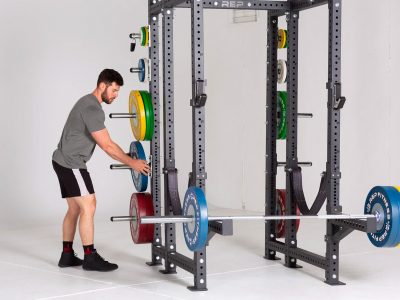Are you unsure about which bench press variation is best for maximizing your workouts: dumbbells or barbells?
With studies showing that the dumbbell bench press activates more pectoralis major and biceps brachii muscles than its barbell counterpart, it’s clear this may not be a straightforward decision.
Bạn đang xem: What’s Better Dumbbell Or Barbell Bench Press Updated 07/2024
This blog will guide you through the key differences between these two popular weightlifting exercises, pointing out their unique benefits and drawbacks relative to your individual fitness goals.
Let’s dive in and discover which one promises to pump up your progress!
Differences Between Dumbbell Bench Press and Barbell Bench Press
Equipment requirements
In a gym setting, the equipment requirement plays an instrumental role in determining your bench press type.
For a barbell bench press, you would need a sturdy and adjustable weightlifting bench and a reliable barbell with varying weights to add on as per your strength level.
This setup takes up more space but creates an environment perfect for controlled progressive overloading – that’s why you see it so often in professional gymnasiums.
On the other hand, dumbbells allow greater flexibility – all you need are two free-weight dumbbells of equivalent weight.
A bonus is that these can easily be stashed under your bed or in the back of a closet. Hence, no extensive gym set-up required!
Despite their versatility and size convenience, progressing with heavy weights might become challenging due to limited increment options on standard home-use dumbbells.
So while both require minimal gear – just something heavy to lift – their usage relies heavily upon individual preference and available resources.
Exercise performance technique
Performing the dumbbell bench press and the barbell bench press require slightly different techniques to ensure proper form and maximize results.
Here are some key points to keep in mind when performing these exercises:
- Start by lying flat on a bench with your feet firmly planted on the ground. Grab the dumbbells or the barbell with an overhand grip, slightly wider than shoulder-width apart.
- Engage your core muscles and squeeze your shoulder blades together to create a stable base.
- Lower the dumbbells or barbell towards your chest in a controlled manner, keeping your elbows at a 45-degree angle from your body. Aim to bring them just below nipple level for optimal chest activation.
- Push through your palms and extend your arms upwards, focusing on squeezing your chest muscles at the top of the movement.
- Throughout the entire motion, maintain stability by avoiding excessive arching of the lower back or flaring of the elbows.
- For the dumbbell bench press, you have more freedom to adjust hand position and grip width as per comfort and muscle targeting preferences.
- The barbell bench press allows for greater load – bearing capacity due to its fixed range of motion, making it an ideal exercise for progressive overload.
- To avoid potential shoulder strain while performing either exercise, make sure to initiate each rep with proper scapular retraction (shoulder blades pulled back) and maintain this position throughout.
- It’s important to breathe in during the eccentric (lowering) phase and exhale during exertion (pushing upward) to maintain proper breathing technique throughout each set.
- Remember that mastering proper form is crucial before increasing weight or intensity levels in order to minimize injury risk and attain optimal results from both exercises.
Emphasis on muscle groups
The dumbbell bench press and barbell bench press both target the chest muscles, but they emphasize different muscle groups.
While the barbell bench press primarily targets the pectoralis major (chest) muscles, the dumbbell bench press also heavily activates the biceps brachii in addition to targeting the chest.
This is due to the increased demand for stability when using dumbbells, as each arm has to work independently.
Additionally, some studies suggest that the range of motion is greater with dumbbells, leading to more overall muscle activation compared to barbells.
So if you’re looking to really engage your chest and biceps during your upper body workouts, incorporating dumbbell bench presses into your routine can be beneficial.
Range of motion
The range of motion is an important factor to consider when comparing the dumbbell bench press and the barbell bench press.
Xem thêm : Best Gym Machines For Arms Updated 07/2024
The dumbbell bench press allows for a greater range of motion compared to the barbell bench press.
This means that you are able to bring your arms further down towards your chest, which leads to increased activation of the chest muscles.
With the barbell bench press, on the other hand, your hands are fixed in place on the bar, limiting how far down you can bring them.
However, it’s worth noting that while the dumbbell bench press may offer a greater range of motion, it also places more demand on stability due to independently moving weights.
Ultimately, choosing between these two variations depends on individual preferences and goals.
Pros and Cons of Dumbbell Bench Press
Benefits of dumbbell bench press
Firstly, using dumbbells allows for a greater range of motion compared to the barbell bench press.
This increased range of motion can lead to better muscle activation and development in the chest, shoulders, and triceps.
Additionally, the use of dumbbells requires more stabilizer muscles to be engaged during the exercise. This helps improve overall stability and balance while also enhancing coordination.
The demand for stability with dumbbells also means you’re less likely to rely on one dominant side or compensate with other muscles during the movement.
Furthermore, research has shown that the dumbbell bench press activates more pectoralis major and biceps brachii muscles compared to its barbell counterpart.
This means you can achieve greater muscle engagement and potentially better results when targeting these specific areas.
Finally, using dumbbells provides versatility as you can adjust weights independently on each side.
This allows for asymmetrical loading if needed, which could be beneficial for addressing any muscular imbalances or working towards individual strength goals.
Drawbacks of dumbbell bench press
One drawback of the dumbbell bench press is that it may not allow for as much weight to be lifted compared to the barbell bench press.
Since each hand holds a separate dumbbell, it requires more stabilization and coordination from the muscles, which can limit how heavy you can go.
This could potentially impact strength gains if your main goal is to lift heavier weights over time.
Additionally, because of the smaller range of motion in the dumbbell bench press, it may put less direct emphasis on chest muscle activation compared to the barbell bench press.
However, it’s important to note that these drawbacks may vary depending on individual goals and preferences.
Pros and Cons of Barbell Bench Press
Benefits of barbell bench press
The barbell bench press offers several benefits that make it a popular choice among weightlifters. One major advantage is the ability to handle heavier weights compared to dumbbells, which can lead to faster strength gains and muscle growth.
Xem thêm : Is Rowing Machine Good For Your Back Updated 07/2024
This exercise also allows for a more stable lifting position, as both arms are connected through the barbell, providing a solid foundation for building upper body strength.
Additionally, the barbell bench press directly targets the chest muscles, allowing for maximum hypertrophy and definition in this area.
Overall, incorporating barbell bench presses into your upper body workouts can help you achieve greater strength and size while effectively working your chest muscles.
Drawbacks of barbell bench press
The barbell bench press certainly has its drawbacks. One of the main disadvantages is that it places a greater demand on stability compared to the dumbbell bench press.
This is because both arms are fixed in position, which can increase the risk of imbalances and muscle compensations if proper form and technique aren’t maintained.
Additionally, some lifters may find it more challenging to achieve a full range of motion with the barbell due to restrictions caused by their individual body mechanics.
Furthermore, while barbells allow for heavier weights to be lifted, this can also pose a potential risk for injury if proper form and control are not prioritized.
The fixed path of the bar limits natural movement patterns and can put unnecessary strain on joints such as the shoulders or wrists.
It’s worth noting that depending on personal goals, certain muscles may not be targeted as directly with the barbell bench press compared to using dumbbells since both arms work together rather than independently.
Ultimately, when considering whether to choose dumbbells or a barbell for your bench press workouts, it’s crucial to factor in your specific goals and preferences alongside any limitations you may have.
Choosing Between Dumbbell and Barbell Bench Press
- Goals: Consider your specific fitness goals, whether it’s building muscle mass, increasing strength, or improving overall upper body strength.
- Experience level: Take into account your experience with bench pressing and weightlifting in general. Beginners may find it easier to start with the barbell bench press before progressing to dumbbells.
- Stability and balance: Assess your stability and balance abilities. The dumbbell bench press requires more stability due to the independent movement of each arm, while the barbell provides more stability through a fixed grip.
- Range of motion: Evaluate how important a full range of motion is to you. The dumbbell bench press allows for a wider range of motion, while the barbell may restrict it slightly.
- Muscle activation: Consider which muscles you want to target more during the exercise. The dumbbell bench press activates more stabilizer muscles and potentially provides greater muscle activation overall.
- Injury history: If you have any past injuries or limitations, take them into account when choosing between dumbbell and barbell bench press variations. Dumbbells can be advantageous for those with shoulder or wrist issues due to their independent movement.
- Equipment availability: Consider the equipment available at your gym or home setup. If you only have access to one type of bench press equipment, that will limit your choice.
Recommendations based on individual goals and preferences
When selecting between the dumbbell bench press and the barbell bench press, it is important to consider your individual goals and preferences.
If you are looking for greater muscle activation and a wider range of motion, the dumbbell bench press may be more suitable for you.
This exercise targets the pectoralis major and biceps brachii muscles more effectively compared to the barbell bench press.
Additionally, if stability training is a priority for you, opting for dumbbells can challenge your body’s stability to a greater extent.
On the other hand, if strength gains and lifting heavier weights are your main objectives, then the barbell bench press may be more beneficial. Barbells allow for progression at a faster rate due to their ability to handle heavier loads.
Furthermore, if triceps development or targeting specific muscle groups is important to you, using a barbell can provide better results.
Conclusion
In conclusion, the debate between dumbbell and barbell bench press ultimately boils down to individual goals and preferences.
Both exercises offer unique benefits and drawbacks, such as increased stability demand with dumbbells and the ability to lift heavier weights with barbells.
To maximize results, it’s important to consider factors like muscle activation, range of motion, and personal strength levels when choosing between these two popular variations.
So whether you prefer the versatility of dumbbells or the raw power of a barbell, both can be effective tools for building strength and size in your chest muscles.
Nguồn: https://usgyms.net
Danh mục: Gym Equipment










